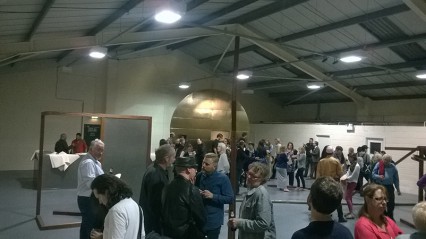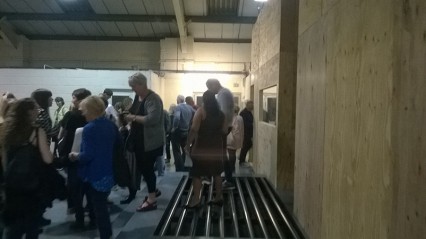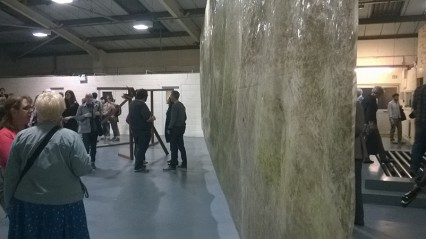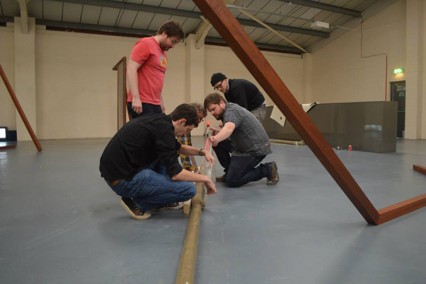g39, Cardiff
4 October – 13 December
If you don’t siarad y Gymraeg you’d be forgiven for thinking that UDO was a type of Japanese vegetable, but it’s actually a Welsh word meaning ‘howling’ or ‘to howl’ (you pronounce ‘UD’ as in the religious festival ‘Eid’ along with an abrupt ‘O’ as it’s pronounced in ‘lot’). You won’t learn how to pronounce it from the blurb that accompanies this show, but what you do learn is that Carwyn Evans’ practice ‘draws directly from his or obliquely on his own personal, cultural experiences while exploring broader social and political shifts’.
Goddamn. Directly and obliquely? Not much room for manoeuvre there. As I’m sure you’ve noticed, Carwyn – who let’s not forget won the Gold Medal for fine art at the 2012 Eisteddfod – should probably also win a gold medal for pointing out the bleeding obvious. I’ve yet to meet an artist of any discipline, whether it be poetry, sculpture, music or dance, whose work isn’t informed by their daily experience. And the fact that he explores things as they are, as they have been, and as they could be is irrelevant, as everyone does that also, whether directly or obliquely.
The blurb itself is one of my favourites of all time, as it also tells us that ‘Carwyn’s sculptural work results from the overlaying of two contrasting cultures – that of agriculture and haute couture. His work is concerned with the inevitability that when we consume we produce, expressed by the logical relationship between eau-de-toilette and a turd.’
You probably think I made that up, so I’ll just casually leave this link here as proof. Now please answer me this – are you as baffled as I am? Haute Couture is represented by ‘eau de toilette’ I guess, even though I just checked my bathroom and the same term is on my £2.88 can of Lynx Africa. And I’ll also have to guess that the scatological element of the blurb is represented by agriculture, because, you know, cows do poos and stuff. But if they are indeed two contrasting cultures, how do they have a ‘logical relationship’? And more to the point, why should we even care? Are we really meant to take this guy’s art seriously after reading such a preposterous piece of literature? Because he obviously doesn’t take it seriously himself, if that’s how he views it.
(Not that there’s anything wrong with not taking art that seriously – Evans’ Cymry Cymraeg contemporary, Bedwyr Williams, has built a lucrative career around the practice. His overly dramatic pisstake known as Bard Attitude, which has been shown in the past at the National Museum in Cathays Park, cracks me up whenever I see it.)
If you want to know why we should care it’s because of this: despite my facetious reservations with the blurb, Carwyn Evans does indeed take his work seriously and he has managed to put a good-looking collection together. You will find yourself rewarded if you spend some time at his show. If it was bad then it would have already been pointed out that UDO is a ‘howler’ of a show, because bad puns like that are manna to a critic, and this show is not deserving of such a lazy dismissal.
For the most part, UDO is a beautifully composed body of work. It perfectly captures the Reveal/Conceal theme of the inaugural Cardiff Contemporary, which Carwyn has launched with this show. To get to the art in question you must amble up an inclined corridor on immediately entering g39, before crossing a cattle grid. It’s a great idea. You’re in the artist’s world now. It’s what Joseph Campbell would have called ‘Being swallowed into the unknown’. You are Jonah and this is the belly of the whale.
Then you’re confronted with a huge, mucky polythene tarp, which blocks your view of the rest of the space. You have to go deeper, and further down the rabbit hole before getting to your prize.
Around the other side is where the rest of the show is to be found. In the foreground is a curiously angled sapele landscape reminiscent of some of Carwyn’s pieces in ‘o’, a show at the Wales Millennium Centre earlier this year (which also, like UDO, featured abandoned shoes hanging from frames and references to perfume).
The enigmatic ‘turd’ of the blurb does actually find a physical form here, dividing the gallery space directly down the middle. It acts as another one of those borders you must cross, like the cattle grid or the polythene tarp. It kind of reminds me of when I was nine and went to Bognor Regis with my nan and went to use our caravan site’s public loos, only to find that the cubicle I chose already had a huge ‘deposit’ in it. This deposit was so big and so long that it reached the toilet seat and all I could think was, how the hell is that supposed to flush. And as I was only nine years old, I thought that was a work of art too.
What strikes you about the woodwork frames and the clay turd is that Carwyn chooses his materials as carefully as he chooses his forms. There’s a story behind every choice. The provenance and sourcing of his materials would impress Hugh Fearnley-Wittingstall. The tarp is from an old polytunnel on his family farm, as is the clay that makes the turd (that is, despite the noun used in its description, he at least tells us it’s made from clay). g39’s gallery space is not small by any means, being a former warehouse and all, but he manages to fill it in a sparse yet precise way. It’s all quite touching if you’re aware of the context. You might not even realise the importance of these materials to the artist unless you read the accompanying literature on the way in, but it doesn’t necessarily matter. Be patient with UDO and you will see it for what it is, and not for what it might be supposed to mean.
The other side of the ‘clay dividing line’, as it shall furthermore be known, is the artist’s interpretation of haute couture. This French term – originally applied to the work of an Englishman – relates to high-fashion custom-fitted clothing, made only by hand (and by highly-skilled seamstresses at that). In France it’s even protected by law as to which fashion houses can use it. But for some reason, Carwyn’s interpretation centres around a kitsch, Koonsesque perfume bottle surrounded by a huge gold disc.
Let’s agree on this: perfume isn’t fashion. While perfume can be fashionable, and it would of course take an absolute goober to not acknowledge that the two are linked in popular culture, to purport to displaying an oversized perfume bottle as a representation of high fashion would be the equivalent of displaying a Guinness advert as a representation of French New Wave Cinema.
As a caveat to this I would like to refer you to an earlier paragraph which states that you wouldn’t be aware of this misappropriation of that French term if it wasn’t included in the accompanying literature. Take the work for what it is and you have a great contrast with the more earthy and nature-oriented work the other side of the clay dividing line with the consumer-oriented corner represented by the perfume kiosk.
Pedantry aside, Carwyn does a better job of overlaying these contrasting cultures in a piece centred around the birthing and adopting of lambs. Despite moving to Cardiff to further his artistic career, it’s obvious that the artist still has a certain hiraeth for the way of life he left behind. Away from the brashness of the perfume depository, it’s also where his art is more comfortable and confident.
On a series of filing cabinets lie a number of carefully folded white rubber mats. There’s a hole through the middle of each one, which makes them look like surgical ponchos. The allusion to fashion in this sense is not far off, being that they’re on the same side of the clay dividing line as the perfume display, yet their sterility betrays their purpose. These ponchos aid in the process of skinning, and are used when a lamb’s mother dies and its only real chance of survival is bonding to a ewe who has previously lost her own lamb.
In the artspace, a gruesome yet essential task is reduced down to its bare potential. At last, High Couture and agriculture meet and find a common purpose. I’m reminded of a scene from Peter Ho Davies’ 2007 Booker-longlisted novel The Welsh Girl, where Esther must help her Shepherd father Arthur as he ‘pulled a knife from the hay bale beside him and set about the lamb in his hands, skinning it swiftly and neatly, and she watched, horrified as he tugged the fleece from the flimsy blue flesh of the body with a soft tearing sound.’ Esther has to hold an orphaned newborn while ‘he plastered the dead lamb’s skin over it, tying the strips that had been its legs beneath the warm, trembling belly.’ The ewe, ‘recognising the scent of her own lamb’, accepts the orphan as her own, thus saving its life.
It’s in this kind of amalgamation that Carwyn’s innovative perception is fully realised. Enter the artist’s world and you’ll be glad you did. Just make sure you give UDO time. What with the wooden frames and the giant gaudy perfume bottle and the filing cabinets, you could just go down to the show and get a bit confused and think you’ve ended up on The Crystal Maze. Then you’ll think you have 90 seconds to work out the puzzle while your mates shout random things at you through a small shutter in a large door, while Richard O’Brien plays the harmonica in the background. And as a result, you’ll miss Carwyn Evans’ vision, and forget that you’ve entered into a deeply personal world which confronts the very boundaries of which his own history and culture have been pushed back by consumerism in an ever changing world, and you’ll be worse off for having missed it.















